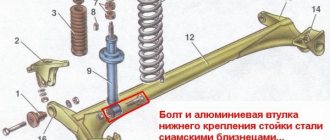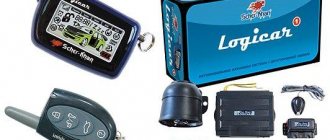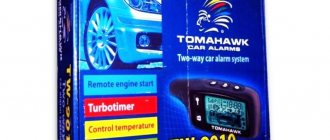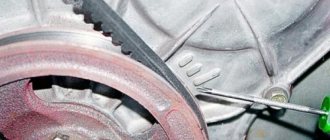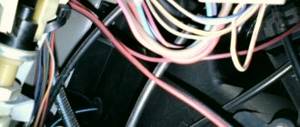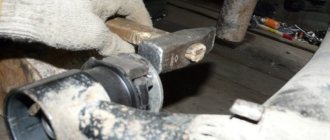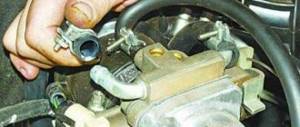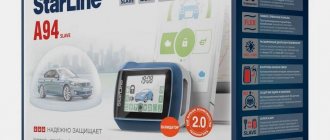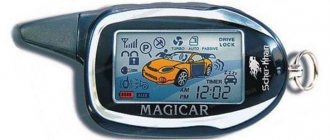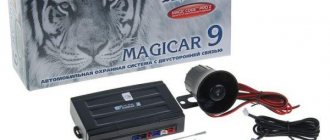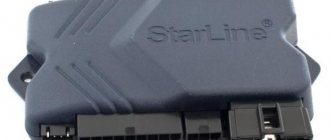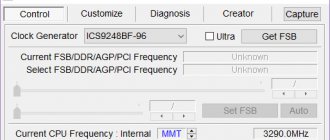Nothing, as they say, was foreshadowed, but what happened happened. While driving in a traffic jam, a “garland” suddenly lit up on the dashboard and the car’s transmission went into emergency mode. Errors on the dash: TPMS system check required Engine check required SCBS system check required
Having connected the laptop and scanned the errors, I saw several errors in different blocks. But as I later realized, the main error code is P0472. In the PCM unit, this error is P0472 - Low voltage of the input signal of the pressure sensor in the exhaust system. In the OBDll unit, this error is P0472 - Abnormality in the exhaust gas back pressure sensor circuit.
Apparently the exhaust gas pressure sensor has failed. But which one exactly? I went to the OD with this question and received a paid consultation =))
The hero of the “triumph” is located here:
On a specialized forum I found a temporary solution: a “trick” of 2 resistors. But while I managed to find out exactly what resistors are needed (and even then I’m not sure that the information is reliable), they have already delivered me a new sensor. About resistors: “I won’t say exactly the nominal value, but you need to get 1V at the signal contact. I even annealed resistors on the machine, I didn’t worry.” - “two 2.2k worked great”
Here, in fact, is the new sensor. Order code SH02-18-211 C
(used to have a "B" at the end)
The new sensor is slightly different in appearance from the old one (partially covered by an orange rubber casing):
After “smoking” this manual a little, I decided that there was nothing complicated and began to change it. Below are short instructions for replacement. There really is nothing complicated, but perhaps it will be useful to someone. I cut the clamp to lift the wiring harness, under which there is a bolt for fastening the metal strip, which in turn holds the sensor hose:
I unscrewed the bolts and pulled out the metal strip:
Disconnected the block (terminal) from the sensor
He loosened the clamp and pulled the sensor fitting out of the hose using rotational and translational movements. I would like to draw your attention to the fact that the plastic fitting of the sensor is relatively long and is reluctant to be pulled out of the hose, plus it is inconvenient to climb up and unclench the clamp.
Next in reverse order:
stuck the fitting of the new sensor into the hose, installed the clamp in place, connected the terminal to the sensor and started the car to check - all the error indicators on the device went out, inserted the metal fastening bar and tightened the bolts (DO NOT overtighten the bolt that is attached to the valve cover, but it we have plastic)
After all this, I connected the scanner and erased the errors:
Issue price: 8838.00 rubles (977.00 - OD diagnostics, 7861.00 - sensor).
UPD 2019
The new sensor with article number SHY6-18-W00 is cheaper and more modernized. The kit includes the sensor itself, mounting bolts, a bracket for a new sensor, wiring and an adapter for a new connector.
Insufficient or too high tire pressure leads to reduced vehicle safety, deterioration of dynamic characteristics and causes increased fuel consumption. Therefore, the Mazda CX 5 uses special sensors.
Installing a tire pressure sensor
Installation and binding of tire pressure sensors is carried out according to the algorithm below:
- Secure the car.
- Jack up the required side.
- Remove the wheel from the vehicle.
- Disassemble the wheel.
- Remove the tire from the rim.
- Remove the existing tire inflation valve. Instead, you will need to install a pressure sensor in the future.
- Remove the ring, washer and valve body from the pressure meter.
- Install the sensor into the mounting hole.
- Tighten the valve. It is not advisable to use excessive force.
- Place the tire on the wheel rim.
- Inflate the tire.
- Check that there is no air leaking through the sensor. If necessary, tighten the valve.
- Install the wheel on the vehicle.
- Inflate the wheels to the required value.
- Perform a “system reset” on the on-board computer.
Typically, sensor binding occurs automatically. If this does not happen, then you need to move the engine start push-button switch to the ON position and then back to OFF or ACC. After this, you should pause for 15 minutes.
To register code signals from sensors and ensure correct operation of the system, you need to drive for 10-30 minutes at a speed of more than 25 km/h. If the warning light does not go off, then you need to stop the car for 15-25 minutes and then continue driving for 10-30 minutes at a speed above 25 km/h. If the binding does not occur, then the problem may be related directly to the sensor.
Operating principles of SCBS
The operating principle of the City Braking System (SCBS) is based on the recognition of oncoming obstacles and the automatic application of the brake pedal. Infrared sensors on the windshield detect obstacles at a distance of 6 meters, and if the driver does not try to avoid them, the program begins to build up pressure in the brake system, helping to carry out an emergency stop of the car. Once the danger has passed, the system releases the pressure levers and the vehicle returns to normal operation.
Attention! SCBS can completely prevent an accident at a speed of 15 km/h and significantly reduce its consequences at 30 km/h.
If the on-board computer displays information about a Mazda SCBS malfunction, it is better to play it safe and go to a service station, as problems with the braking mechanisms can lead to an accident.
Cost and article number for sensors for Mazda CX 5
The original tire pressure sensor for the Mazda CX 5 has the article number BHB637140. Its price ranges from 2000 to 4000 rubles. Sensors from third party manufacturers are commercially available. The table below shows the best analogs that have proven themselves on the Mazda Cx 5.
Table - Tire pressure sensors Mazda CX 5
| Firm | Catalog number | Approximate cost, ruble |
| Jaguar | C2C41655 | 6000-9000 |
| Mobiletron | TXS034 | 1300-2800 |
| Volvo | 31341893 | 5000-7000 |
You can check the functionality of the sensor by forcibly releasing some of the air from the wheel. In this case, after a while a message indicating that the tire pressure is too low should appear. Checking the TPMS system is also possible by reading errors from the on-board computer.
Manufacturer's recommendations
For the program to function properly, it is recommended to disable the SCBS system of the Mazda CX-5 while driving off-road. There are also several rules that must be followed to ensure correct operation of SCBS:
- all wheels must have the same tires, suitable for the standard size;
- the luggage compartment must not be overloaded;
- It is necessary to promptly clean the windshield from dirt.
The sensitivity of the sensor may decrease due to:
- bad weather;
- high level of pollution of a car moving towards you.
The safety braking system will operate normally provided that:
- trouble-free operation of the motor;
- no software errors;
- driving at speeds from 4 to 30 km/h;
- functioning of the traction control and anti-skid system;
- ride on high-quality and unworn tires.
Mazda cars are rightfully considered one of the most reliable in the world, and the latest safe braking system in the city is proof of this. If the SCBS sensor is working properly, the risk of accidents on the road is minimized.
I would like to exchange experience in using a series of intelligent solutions of innovative technologies i-ACTIVSENSE. By default and in option packages there are: HL - Adaptive lighting system with automatic control of luminous flux; LDW & LKA - lane departure warning systems; BSM - blind spot monitoring system; City safety braking system SCBS (rear); Traffic Sign Recognition System; Driver Attention Alert; Emergency response system for accidents ERA-GLONASS Now let's go through in more detail: 1. Adaptive lighting system (Adaptive LED Headlamps) analyzes the situation on the road at night and automatically adjusts the luminous flux. Thus, the ALH system reduces the brightness of only that part of the high beam headlight beam that can blind oncoming drivers. If a passing vehicle overtakes, the system switches the headlights from high to low. When crossing intersections, the low beam beams of the headlights expand the illuminated area on both sides of the vehicle, which helps the driver notice pedestrians. Also, when you turn the steering wheel, the beam of light also turns. It’s difficult to see exactly how it works, but I can definitely say that the light is simply gorgeous! Especially after three.
Read more: What is the fine if the license plate light does not light up?
2. Lane-Keep Assist System monitors your vehicle's position relative to lane markings and helps prevent you from unintentionally drifting out of your lane. The driver is first alerted by an audible signal and vibration of the steering wheel. The system then automatically returns the vehicle to the center of the lane if necessary. A very cool thing where you can clearly see the stripes (like in our region), and where there are almost no cars. The car just steers itself) and warnings about driving on the median are displayed. It’s a little scary and you shouldn’t rely on it completely, but it’s an interesting thing!
3. Blind Spot Monitoring system helps the driver control the traffic situation when trying to change lanes. The system monitors a vehicle approaching from behind and alerts the driver to it with a light indicator on the side rear view mirror. Everything is clear here, I’ll only add that it works a little early and sometimes it would be possible to change lanes, but it already squeaks, vibrates the steering wheel and tries a little to return it to the lane. It also shows the danger on the frontal projection (if any) and when leaving a parking lot in reverse, warns that someone is approaching perpendicularly (RCTA).
4. The system of safe braking in the city (Advanced Smart City Brake Support) constantly monitors the distance to the object moving ahead and the speed of approaching it. If the likelihood of a collision increases, the system applies the brakes. In this way, Advanced SCBS minimizes the risk of collisions at speeds of up to 80 km/h. Well, I haven’t been able to try it yet and again there’s no point in hoping) It seems like if you back up, it can also stop the car before a collision.
5. The Traffic Sign Recognition system reads speed limits and “no entry” signs, and if their instructions are violated, it gives an audio and visual alert. When activated, Navi is also automatically activated. It won’t be superfluous either, as long as the signs are in accordance with GOST)
6. Driver Attention Alert. When the vehicle is moving at speeds above 65 km/h, the system monitors the vehicle’s position relative to road markings, takes into account speed, steering angle and travel time. If the driver begins to lose vigilance, the system gives a signal and offers to rest. I can’t say anything - I rarely travel for a long time
Read more: Mazda cx 5 pads
7. ERA-GLONASS is a system for calling emergency services by pressing one button manually or automatically. In the event of an accident or other emergency situation, the system determines the location of the vehicle and transmits the necessary data to the call center. In accordance with the information received, the dispatcher organizes the departure of an ambulance or rescue team to the scene of the incident. "ERA-GLONASS" operates in automatic or manual mode, allowing you to reduce the response time of emergency services by 30%. You know everything yourself - you obliged everyone)) The price has increased by 20-30 thousand for this reason. I hope it never comes in handy. 8. Cruise control. A very useful thing on the highway! Always wanted 9. Auto Hold. Automatically holds the car in a traffic jam after a complete stop. There is no need to hold the brake and when moving away you just need to press the gas. I don’t understand why it needs to be turned on every time from the beginning of the trip ( 10. i-stop, which was not in the top three before, but many already have it. Its operating conditions cannot always be met, the main thing being that the climate must catch up with the set temperature ( not I like the strong flow of air and the noise from it). I don’t see the point of turning it off when traffic jams are crazy, although it kills the battery faster. 11. A bunch of systems that are already clear - HLA - assistance when starting to move on slopes (it doesn’t seem to work sometimes and the car rolls backwards, you have to be careful), EPB - Electronic handbrake (nice, but in winter there may be problems, it seems), ABS, TCS - traction control system (it was also on the troika - it helps or hinders when there is ice), AWD - everything is clear here (it’s a pity that you can’t drive it and it’s not worth the 100 thousand if driving around the city is 99%), I haven’t tried the sport mode (still running in), etc.
The only thing missing in Russia is MRCC(Mazda Radar Cruise Control)- Mazda Cruise Control (MRCC) uses millimeter wave radar to estimate the relative speed and distance of the vehicle ahead and automatically controls the vehicle's speed. Operating within a preset speed range, MRCC automatically adjusts and maintains a safe distance to the vehicle ahead, thereby relieving driver stress on long drives and on highways. Also includes a Distance Recognition Support System (DRSS), which visually displays the next distance to help the driver remain aware of important safety considerations. We didn’t have time to get permission for this thing, so it’s not there yet(
In general, you can do without all this and the price for all this is a little overpriced, I think. And then we’ll see how it all behaves) What do you think about this and how do you use it?
Scbs Mazda CX 5 error
Have you seen, a crossover from a company that has never specialized in this kind of cars is selling better on the Russian market than C- and D-class models from the same company. And among its competitors, the CX-5 at the end of 2014 outperformed such recognized players in the genre as the VW Tiguan, Nissan X-Trail and Honda CR-V. Is this consumer love deserved?
Technique
The CX-5 in many ways became the herald of the next era of the company's development. It was she who was the first Mazda to try on a new design style - “soul of motion”, or Kodo in Japanese. And it was this crossover that was the first in the line to receive promising units created within the framework, if you like, of the Skyactiv technical philosophy.
If we talk about gasoline engines, then these are traditional volumes (2.0-liter PE-VPS and 2.5-liter PY-VPS), refusal of turbocharging and an “unconventional” compression ratio of 14:1. In addition to the latter there is direct injection, phase shifters on both shafts and a 4-2-1 exhaust tuned. All this together made it possible to reduce the temperature of the combustible mixture, thereby eliminating the possibility of detonation. And this very compression ratio, by the way, together with the long stroke of the engines (when the piston stroke is greater than its diameter) determined good traction at the “bottom” and better overall efficiency.
Interestingly, for the US market the compression ratio was reduced to 13:1. The Skyactiv-G gasoline engines reached us in their original form. And so far the technology in the Russian environment has not revealed any inherent shortcomings. It happens, of course, that the engines “check”, but who is not sinless? “Disposable”, again, is of no use to this now. It’s probably too early to talk about the resource. Nevertheless, there are already cars with mileages of 150 thousand km or a little more. They did not have to adjust the valves or change the timing chains. And the oil consumption allowed by the manufacturer of 800 g/1000 km is nothing more than a safety net: with the most aggressive driving between oil changes, it burns within the limits of the dipstick. Another thing is that you should follow the manufacturer’s recommendations and change the oil (viscosity 5W-30) not after 15 thousand km - after 7500. It’s strange that Mazda began to advise this relatively recently in relation to the Russian market. Among the shortcomings of the engines, for now we note only isolated failures of the air flow sensor and, on the contrary, frequent breaks in one of the drive belts. The one that rotates the air conditioner and generator. This is due to the i-stop system, which turns off and starts the engine during short stops in city traffic. This mode of engine operation affects the life of the drive. And if you additionally load the belt with air conditioning, it may not last even 50 thousand km. And this is a non-warranty case!
The 2.2-liter 175-horsepower diesel SH-VPTS has not yet revealed its operational secrets - diesel is not honored on crossovers in Russia. However, technically the engine is also interesting. For example, the compression ratio is unusually low for units operating on heavy fuel - the same 14:1. This is done so that it is possible to naturally (without the use of catalysts for nitrogen oxides) meet Euro-6 standards and at the same time obtain excellent traction at the “top”. The red zone starts at 5000 rpm, and the SH revs willingly until there! True, for our market the diesel engine was adapted to Euro-4. Other features include sequential turbocharging with two volutes of different sizes and something similar to Honda’s VTEC mechanism. Additional cams on the exhaust camshaft, slightly opening the valves on the intake stroke. In this way, exhaust gases are released into the combustion chamber, which makes it easier to start and warm up the engine in cold weather. It should be noted that all three engines start well in cold temperatures of -30.
The CX-5's six-speed automatic transmission is also new. It bears the brand designation Skyactiv-Drive and factory indices FW6A-EL (front-wheel drive) and FW6AX-EL (4WD). Like a diesel engine, the box has not yet demonstrated its operational nuances. Nevertheless, we can make some predictions. The unit, according to some information, created in collaboration with Aisin, blocks the torque converter from minimum speed and, “distracted” by gear changes, strives to return to a rigid transmission connection, eliminating hydraulic losses. In general, the same principle of operation has been used for a relatively long time on automatic transmissions from the same Aisin, GM, ZF, etc. “In the steering wheel” this allows more precise and complete control of traction and saves fuel. However, constant slippage of the discs blocking the torque converter heats up the box and contaminates it with friction wear products. Modern automatic transmissions from different manufacturers have a lifespan of 100–300 thousand km. FW has already crossed the lower resource threshold. To run longer, you don’t need to get carried away with aggressive driving and change the oil more often (every 30–50 thousand km).
There are no particular problems with the six-speed manual transmission. Unless the clutch drive freezes at minus 30 and below. Moreover, other owners complain about 1st, 3rd, 4th and reverse gears being reluctant to engage. And they also note the noise of the clutch bearings, which are interlocked with the rear gearbox and provide the CX-5 with all-wheel drive. Dealers, however, do not confirm this. But the alarming thing is that the clutch is not blocked in any way. Will it get hot when slipping?
There are no revelations in the suspension - McPherson at the front, multi-link at the rear. There are no complaints about most elements, but there are a few things that let me down. For example, until recently, the plastic housings of the support bearings of the front struts could be destroyed on uneven surfaces. Now they are metal. The anthers on the same struts also burst; they are still being replaced under warranty, although Mazda uses new material. What else requires attention in the chassis is the left steering rod, which, when the wheels were turned out, touched the rack body. The problem was solved either by adding lubricant or replacing the rod. Wheel bearings are also changed - at 50-60 thousand km. Alas, for many modern cars they are consumables.
More questions about the CX-5 arise from small things. Or it arose - some defects were recognized by the manufacturer and eliminated as part of recall campaigns, something is eliminated upon its occurrence. Thus, the rear view mirrors and the hood, whose canvas extends from the amplifier, vibrate at speed. The front door windows rattle. On versions with mechanical adjustments, the driver's seat itself lowers, which, moreover, burns out the heated cushion. And the seams of the leather upholstery on the backrests diverge in both front seats. The steering wheel turns white (either wears out or fades) and the chrome exterior parts begin to bloom. The ceiling upholstery gets wet due to condensation.
Separately, it is necessary to mention electronic glitches. If a burning tire pressure monitoring light can be attributed to improper use of this system, then the rear view camera fails “thanks to” its own malfunctions. It happens that the horn does not work in cold weather. And distorted characters in the speed dial window are an officially recognized multimedia “bug”. Owners complain about an allegedly faulty blind spot monitoring system and adaptive lighting that functions intermittently. And the inability to turn off the engine, that is, the start button is not working. And to the radio, which turns off either with a delay or does not turn off at all. Here you need to understand that many functions are controlled from the menu, and to use them correctly, you should at least look at the instruction manual.
This must also be done in order to operate the i-stop system. Available even in the basic configuration, it is extremely demanding on battery charge. And if it is not enough, i-stop begins to rebel, as does the network of the car itself. When the car is idle, the battery must be recharged. Moreover, it is impossible to replace the original battery with any one. You need one that is designed to work with stop & start systems. At least, there were cases when the CX-5 “rejected” the battery.
Such paradoxes! The technology, to which there were questions about its viability in general and especially in our conditions, works and does not manifest itself negatively in the Russian environment. But some household things, seemingly supposed not to cause problems, annoy you with small dirty tricks. As a result, it looks as if the Mazda team, having thrown all their efforts into their Skyactiv, paid little attention to the crossover itself. One thing is good - the Japanese know how to admit their mistakes and, drawing conclusions, eliminate them.
Express test
Surely for most who bought the CX-5 it was love at first sight. Looking at such, I’m not afraid to say, sexy shapes, you’ll forget about the performance characteristics and the equipment that Mazda, by the way, pampers you with. And the price, which is higher than that of some competitors, is the last thing you will be distracted by. The CX-5 is a choice, first of all, not of the mind but of the heart.
And the inside is also beautiful and, by the way, expensive. Despite the fact that the company has never declared its desire to reach the notorious premium, it is already “in it.” Moreover, the matter is not only in the selection of materials for the front panel, nor in the adjustment of joints. In regards to detail! Whatever you touch - the electronic parking button, the joystick of the mirrors, the "twist" controls of the multimedia complex or other things - there are pleasant tactile sensations and measured efforts everywhere. Remove the emblem and... “German”? If anything, this Mazda is every bit as good as the best of its competitors.
The seating position is also a revelation - even though it’s high for an off-road vehicle, there is still enough space in both length and headroom. At the same time, the seat hugs the body like a car with lateral support bolsters, helpfully offering lumbar support. There is also plenty of space in the back, although Mazda is unlikely to be able to claim leadership in the class here. As for the trunk, its main advantage is the remote folding of the rear seatbacks and the resulting flat area for cargo.
A running feature of all the latest Mazdas was a detailed broadcast into the cabin of any road irregularities and voiceover of the suspension operation. The CX-5 chassis is made in the traditions of the brand, but with a class-appropriate correction. The dull sobs of the rear multi-link are heard only on large potholes that are stormed by the move. And the crossover rounds other seams and joints quite adequately. And yet, no, no, yes, it will allow a noticeable poke inside from a seemingly frivolous asphalt patch. Of course, this can partly be attributed to the 225/55R19 tires that Mazda flaunts in the maximum configuration. However, they cannot be held responsible for the lack of energy intensity. From a crossover, even if it is tailored for active driving, I want a different attitude towards the Russian road environment.
Moreover, the handling itself is not without flaws. At least in that part that concerns the steering, namely the electric power steering. In the near-zero zone, the steering wheel is filled with excessive force, and when turning it at small angles there is not enough sensitivity. At the same time, Mazda still drives clearly in an arc with a smooth surface and does not frighten with large rolls. But in ruts pressed into the asphalt on a straight line it behaves nervously - it yaws, demanding steering.
The highlight of the CX-5's driving habits is the combination of a 2.5-liter engine and an automatic transmission. It’s great (in terms of road behavior) that Mazda engineers chose an automatic transmission rather than a CVT. It quickly changes gears, quickly adapts to the driving style and, in manual mode, honestly holds the selected gear up to the limiter. It's good that there is no CVT here, also because the engine is noisy. But the crossover with it is dynamic and easy to climb throughout the entire speed range - it pulls confidently at the bottom and spins willingly. In general, it is pleasant both in the city and on country roads. Off-road is another matter, no, even light cross-country. You look at the front overhang (the approach angle is only 18.6), you remember that the clutch has no forced locking - and somehow you don’t want to drive off the asphalt.
Mazda CX-5 configurations and technical specifications
The minimum price for which you can purchase a CX-5 is RUB 1,214,000. and Drive . A two-liter engine, a manual transmission (automatic plus 80,000 rubles), a stabilization system and a full set of airbags (front, side, curtains) and a standard power package with air conditioning, music and heated front seats - the car is far from empty.
Starting with the Active (which benefits from dual-zone climate control and cruise control, a display, and lumbar support in the driver's seat), packages can be ordered in addition to the basic equipment. For example, from LED foglights and headlights with an adaptive lighting system (RUB 45,400), which can be used to “finish off” a crossover for RUB 1,344,000. But the same Active, but for 1,444,000 rubles, already includes two packages - a dimming mirror, a rain sensor and a city braking system SCBS (40,000 rubles); and combining the first two packages (RUB 85,400). It is from this amount that all-wheel drive “starts”.
The Supreme (RUB 1,534,000) adds leather upholstery, an electric driver's seat and some things that were previously options (light and rain sensors, the same SCBS emergency braking system). The packages are richer in lane control systems, blind spot monitoring, an electric sunroof and an audio system with Bose acoustics. All this, including LED headlights, can be arranged in different ways. In this case, the CX-5 will cost from 1,579,000 to 1,682,600 rubles.
A crossover with a 2.5-liter engine is only available with 4WD and an automatic transmission and does not have a basic configuration. Active+ is available from RUB 1,534,000, and packages can raise its price to RUB 1,634,800. Supreme is estimated at RUB 1,624,000–1,772,600. However, the diesel version is even more expensive. For Active they ask in the range of 1,671,000–1,763,000 rubles. For Supreme - 1,770,000–1,918,600 rubles. Moreover, buying a CX-5 in the maximum configuration and ordering the most expensive of the packages, there are still options on which you can spend money. So, in any case, you will have to pay extra for metallic paint (15,500–20,500 rubles), for navigation (22,000 rubles) and for an additional security system, regular or satellite (35,900 and 46,900 rubles, respectively).
Specifications Mazda CX-5
Prices and competitors
Typical prices for used Mazda CX-5 in comparison with competitors (thousand rubles):
A used Mazda will allow you to save some money only in one case - if you choose simple versions, front-wheel drive or without 4WD at all and with a manual transmission. These are found on the market and cost a minimum. But when the car is well packaged and especially has a 2.5-liter gasoline or diesel engine, then you shouldn’t count on any dumping. Of course, we can’t talk about a significant revaluation of the CX-5’s capabilities in rubles. And yet, on average, Mazda is usually not much more expensive. In terms of versions, two-liter ones prevail, but you can find a crossover with a larger engine. Diesel is exclusive.
What to look for when buying a used Mazda CX-5:
— Performance of turbines on diesel engines — Condition of the drive belt of the generator and air conditioner on gasoline engines — Condition of ATF in the automatic transmission, quality of gear shifting — Operation of all electronic systems — Full check of all basic and optional equipment
Cost of technical service at dealership centers, rub.:
Safety
The Mazda CX-5 was crash tested according to Euro NCAP, and received maximum marks in all categories - frontal impact, side impact, pole impact and child protection.
This is not surprising - as mentioned above, even in the basic equipment the model has an impressive safety package, consisting of front and side airbags, as well as curtains. Except that the protection for the driver’s chest and shins turned out to be less than ideal. The front edge of the hood was found to be hazardous when colliding with pedestrians. And points were deducted during the test to ensure the safety of a one-and-a-half-year-old child (as opposed to, by the way, a three-year-old). Still 16 points and five stars. It is worth noting, however, that there is also the merit of electronics here, such as the exchange rate stability system, available “in the base”; blind spot monitoring systems, lane marking monitoring systems, etc.
The Mazda CX-5 passed tests using the methods of the US National Institute for Highway Safety with excellent results. These include frontal, side, rear and roof rigidity tests. The result would not have been possible without the widespread (up to 61%) use of high-strength steels.
Recommended owner reviews
Mazda CX-5 (2013, 2.0 l., automatic transmission, 2WD) by orsk01 Mazda CX-5 (2013, 2.0 l., automatic transmission, 2WD) by Kaleb911 Mazda CX-5 (2014 , 2.5 l., automatic transmission, 4WD) from Andrey G Mazda CX-5 (2013, 2.5 l., automatic transmission, 4WD) from Serparioagro Mazda CX-5 (2012, 2.0 l., Automatic transmission, 2WD) from Deerhunter
